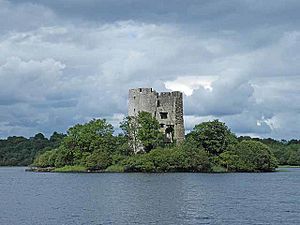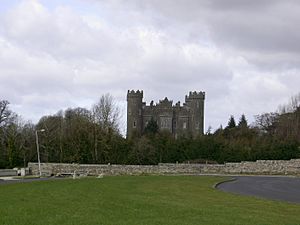Richard Nugent, 1st Earl of Westmeath facts for kids
Richard Nugent, 1st Earl of Westmeath (1583–1642) was an important Irish nobleman and politician. He lived in the 1600s. Richard was put in prison in 1607 because people thought he was planning against the English King. However, he soon received a special pardon from the King. After that, he usually supported the government. But sometimes, people still wondered if he was truly loyal. He died because he refused to fight against the English King during the Irish Rebellion of 1641.
Early Life
Richard Nugent was the oldest son of Christopher Nugent, 6th Baron Delvin. His mother was Lady Mary FitzGerald. Her father was Gerald FitzGerald, 11th Earl of Kildare. Richard became the 7th Baron Delvin in 1602 after his father passed away.
Imprisonment and Escape
The King's government was suspicious of Richard from the start. His father had been in prison for serious disloyalty when Richard was born. His father also died in prison, suspected of planning more acts of disloyalty.
At first, Richard seemed careful. He accepted the King's authority. He was even made a knight in Dublin in 1603. But the government's suspicions were correct. Richard was involved in a secret plan that led to the "Flight of the Earls" in 1607. This was when several important Irish leaders left Ireland.
Richard was put in Dublin Castle. But the castle had loose security. A servant managed to sneak a rope into his cell. Richard used the rope to escape through a window. He ran to Cloughoughter Castle, a fortress owned by his family in County Cavan.
Richard's escape happened when Sir Cahir O'Doherty came to Dublin. O'Doherty wanted to clear up a misunderstanding. People wrongly thought he was planning an uprising. Richard's escape made the government lose trust in even loyal Irish lords like O'Doherty. They suspected O'Doherty was part of a secret plan with Richard. The next year, an upset O'Doherty and his followers attacked the town of Derry. This started O'Doherty's Rebellion.
Royal Pardon
In 1608, Richard appeared before the English King. He had been promised forgiveness by the Dublin government. He asked for a royal pardon. He said he was young and didn't know much about the world. He seemed to be a charming and good-looking young man. King James I liked handsome young men.
Richard was pardoned and became a favorite of the King again. However, he lost some of his lands. This included Cloughoughter Castle.
Political Life
After his pardon in 1608, Richard had a very successful career until 1641. He sometimes disagreed with the government. For example, he opposed the creation of new towns that could send members to Parliament in 1613. He thought this would unfairly increase the number of Protestant members. He also spoke against new settlements in Ossory in 1623-24. He correctly predicted that these would lead to more settlements later.
In 1611, he received land grants in several counties. This included 14,000 acres in County Galway. He built a new home called Clonyn Castle. It was near his family's older home, Nugent Castle. He became a member of the Irish House of Lords in Parliament. He also became a royal commissioner in 1633. This role helped people with their complaints.
He traveled with the Duke of Buckingham, a close friend of the King. They went to the Siege of Saint-Martin-de-Ré in 1627. In 1621, he was given the title of Earl of Westmeath. This showed the King still liked him.
Richard was a main speaker for the Roman Catholic community. Because of this, his loyalty was sometimes questioned. Especially after he opposed the Ossory settlements in the 1620s. But after 1608, his loyalty to the King seemed strong.
In the late 1620s, he helped negotiate special agreements for Roman Catholics. These were known as "The Graces". In 1634-35, the main ruler of Ireland, Thomas Wentworth, 1st Earl of Strafford, canceled these agreements. Richard found it hard to work with the powerful Strafford. Because of this, he mostly stopped public life in the late 1630s.
Death
When the Irish Rebellion of 1641 began, the Earl stayed loyal to the King. This was unlike many other Anglo-Irish nobles. However, at least one of his sons joined the rebels. The government worried about Richard's safety at Clonyn. They sent a group to take him to Dublin.
This group was attacked by surprise at Athboy. The Earl was captured. He was rescued, but then attacked again near Trim. He was badly hurt in this second attack. He was nearly sixty years old, blind, and had a condition affecting his movement. He died from his injuries.
Family
Richard Nugent married Jenet Plunkett. She was the daughter of Christopher Plunkett, 9th Baron Killeen. Family stories say Lady Westmeath was called Jenny the Scraper. This was because she was very careful with money and didn't waste anything.
They had five sons:
- Christopher, Baron Delvin
- Francis
- John, whose family became the Austrian Counts Nugent von Westmeath
- Lawrence
- Ignatius (died 1671), who was a Colonel in the French army.
Christopher died before his father. He left one son named Richard. This Richard became the second Earl of Westmeath. The second Earl was a leader of Confederate Ireland, a group that fought against the King. He faced many difficulties because of this. But he was rewarded when King Charles II returned to power.
They also had two daughters:
- Bridget
- Mary.



